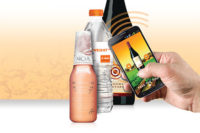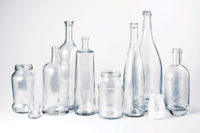Coffee pouch let’s you brew coffee on demand and on the go
Nature’s Coffee Kettle is a coffee brewing system for campers, hikers and coffee connoisseurs. Now the company’s updated spouted pouch from Flair Flexible Packaging helps Nature’s Coffee Kettle better communicate the unique brewing method and the freshness of the custom-roasted gourmet coffee.
“The technology is clearly in the bag,” says Matt Hustedt, founder of Nature’s Coffee Kettle of Omaha, NE. “Our customers brew 32-ounces of gourmet coffee when they are on-the-go.”
To use Nature’s Coffee Kettle, a user pours hot water into the pouch and through a proprietary self-contained filter pack filled with freshly roasted and ground coffee. After a few minutes, grasping a two-finger die-cut handle, the coffee is ready to be poured through a second spouted opening. The insulating properties of the custom engineered multilayer flexible pouch allow the user to safely handle the pouch even when boiling water is poured inside.
Nature’s Coffee Kettle’s recent packaging upgrades include new photo-quality full coverage graphics, an ergonomically improved die cut pour handle, curved corners and an enhanced coffee filter.
Label technology keeps cans and bottles colder for longer periods
Commodore Plastics introduces a new way to keep aluminum cans and bottles colder, for longer periods of time. The company’s new Labec foam label stock is targeting both large and small breweries. Commodore has developed a technique for coextruding polystyrene (PS) foam shrink-label stock that insulates aluminum, glass and PET beverage containers, keeping liquids colder, for longer. The label also provides breakage protection to glass. Commodore tests have demonstrated that Labec foam PS labels keep beverages colder an average of 15 to 20 minutes longer than plain cans, based on a beverage-temperature gain without the label of 20 to 30°F over the course of one hour.
Labec PS foam labels may be printed, hot-stamped for a premium look, metallized and embossed, among other options. Also, the insulating properties of Labec foam mean the beverage may be enjoyed straight from the can without any of the extra moisture and condensation inherent in aluminum cans as they warm towards room temperature. In addition, says Brad Braddon, president of Commodore Plastics, “The labels can improve recyclability of containers, if left on aluminum cans or ground up with glass bottles. The fuel value of the label replaces 5 to 8% of the natural gas used in recycling.”
EASY OPEN CAN IS RESEALABLE
Munich-based can2close GmbH, founded in 2012 by Andreas Kleiner, Robert Kruetten and Moritz von Grotthuss presented its “c2” resealable end, a new mechanism that replaces the standard stay-on tab opening of beverage cans with a simple mechanism that is easier to open and can be repeatedly sealed – a feature present on plastic bottles and other types of beverage containers but that is not yet well solved for cans. can2close´s patent-pending solution offers a number of advantages for the consumer, including the ability to portion canned beverages and easily transport them after the first opening. The resealable end also keeps drinks fresher, prohibits unwanted contaminants and reduces the risk of spilling. The plastic mechanism can be opened with one hand, while the larger opening releases more aroma and flavor and is usable with a straw. The solution offers beverage brands a new innovation and a great branding possibility, as the shape and color of the closure components are customizable. can2close also states that filling companies can easily integrate the resealable end into established filling processes.
can2close has been recognized with an award at the Munich Business Plan Competition (Münchener Business Plan Wettbewerb Step 1). Also, in September 2012, can2close received the Silver award in the Prototype category of the “Cans of the Year Award” in Tokyo.
Open top can offers 360 degree drinking
Crown Holdings, Inc. introduces its first commercial application of its full aperture end in North America. Sly Fox Brewing Co. of Pottstown, PA is utilizing the 360 End beverage can technology with its Helles Golden Lager. The entire lid of the can is removable, allowing the user to drink from any of the can’s sides. Sly Fox beer with the 360 End debuted at the Craft Brewers Conference in Washington, DC at the end of March.
The 360 End metal can is 100% recyclable and infinitely recyclable, meaning it can be reused again and again with no degradation in quality. The full aperture end created for the Sly Fox Brewing Co. cans takes sustainability one step further by using Crown’s patented SuperEnd beverage ends. The ends use 10% less metal than traditional beverage ends and make cans even more environmentally friendly.
Test tube wines let you taste new varietals
Miami entrepreneur and boutique winery owner, Sunny Fraser, debuts The Vini - Exceptional Wine by the Glass, the world’s first-ever fine wine available by the glass. The Vini, currently available in South Florida, offers both red and white fine wines available in a 187ml sleek glass tube. The brainchild of wine lover Sunny Fraser, The Vini was created to fill a major void in the wine market. Prior to the invention of The Vini, sampling a fine wine was a privilege only available to wealthy wine enthusiasts. Fraser’s creation now makes fine wines approachable to the masses, offering a generous pour of fine wine without the financial commitment.
The Vini is packaged in a sleek glass tube with a screw tap, offering both a beautiful display and an ergonomic design. The Vini is not only a trademarked brand of proprietary wines called The Vini, but it is also The Vini format, their patented glass container with screw cap closure. Like many other high-end wineries, it uses the industry standard Stelvin screw cap to maintain integrity. Different from other wineries, The Vini is also a state-of-the-art bottling company that owns a proprietary bottling line in Sonoma, CA.
WINE POUCH offers multiple serving conveniences
ecoVINO Helibiker red wine is packaged in a stand-up pouch known as AstropaQ, which uses a Superlam™ lamination and is a partnership with three companies all in the upstate New York region. American Packaging Corporation makes the print and laminate material, PacTech creates the stand-up pouch and ImpaQ sells, markets and distributes the AstropaQ product using the Superlam™ laminate. AstropaQ with SuperLam™ is an all-film/plastic laminate structure, approximately 7 to 8 mils in total thickness, and is approximately a reduction of 10-20 times the thickness, compared to most current containers (glass or blow-molded bottles) in the liquid packaging industry. AstropaQ with SuperLam™ is currently in wine/spirits and beverage markets, primarily as a 1.5/1.75L container. Compared to current glass bottles, these packages feature:
- Minimum 80% less carbon footprint
- Approximately 90% less material (by weight)
- Virtually shatter-proof
- Product is able to be chilled at least 50% faster
- Reverse printed graphics, versus outer labels, resulting in superior scuff resistance and reduced shop-worn appearance
- Lower total cost from cradle to grave
- One-way “breathing”: the spout will only dispense contents out, and not allow air/oxygen in, resulting in longer shelf life after opening.
-
Easy dispensing of product contents:
- Tamper-proof cover for security
- “Press and pour” button feature
- Gravity-driven: no need to tip or pour package to dispense
- Longer shelf life from unidirectional spout
Carton offers three shapes on one packaging machine
For juice and dairy offerings, Tetra Pak introduces Tetra Gemina. According to Tetra Pak, this is the world’s first roll-fed gable topped package. The aseptic carton package is a roll-fed gable top package for full aseptic performance for juice and milk. Tetra Gemina and two innovative shapes, the Tetra Gemina Leaf and the Tetra Gemina Crystal, are available in volumes from 500ml to 1500ml in the square shape and 1000ml for the two new shapes- Crystal and Leaf. Tetra Gemina is a tradition carton shape with a slanted top, Tetra Gemina Crystal features four additional crystal-shaped panels and the Tetra Gemina Leaf features four contoured side panels. The Crystal and Leaf side panels packages are fully printable for enhanced branding and design. All three shapes can be run on the same packaging machine, making it simple to change between the shapes and to introduce a new product or another variety of an existing product line.
WATER BOTTLE dispenses electrolytes, minerals and vitamins, on demand
The emerging “interactive cap” segment of the beverage category now has another player. H2M introduces 989 On Demand, a rehydration beverage utilizing the company’s vacuum-sealed cap, a two-piece unit designed to hold liquid or solid in an air-tight chamber. The cap twists clockwise to release the contents, and then the bottom portion is turned counter-clockwise to open, allowing access to the bottle’s now freshly-mixed ingredients. The cap’s capacity is 13 grams of liquid or powder.
H2M CEO Charles Musumeci, says, “Our cap is not simply head and shoulders above the competition in the beverage category, we are seeing potential use in the pharmaceutical arena, the spirits category and even with certain types of consumer goods. With this utility patent, the door is open to change the way consumers around the world think of ‘mixing’ since our cap delivers an exact amount on demand.”
989 On Demand drink features nine vitamins, 84 minerals and five electrolytes housed in the cap atop 19-ounces of reverse osmosis water. The H2M cap received its first design patent in 2010 on the upper section of the cap (the releasing mechanism) and the second design patent was issued later that same year for the lower section (the housing chamber).










